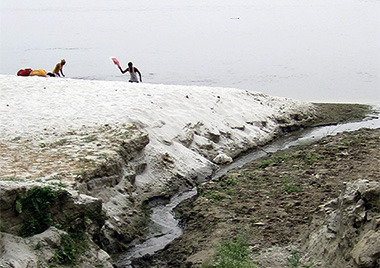The Health of the Ganges and its Ecosystem
The Health of the Ganges and its Ecosystem

India, with a current population of 1.2 billion, is projected to be the world’s most populous nation by 2025. Consequently, emerging Indian markets are attracting much interest from the UK and other western nations and therefore the sustainable development of India is rapidly becoming a global priority. As a result, an increasing number of western scientists are currently engaged in studies which aim to better understand the health of ecosystems in India and, ultimately, contribute to sustainable development. One key ecosystem which facing is a crisis is that of the Ganges river. With a population of 400 million across the Ganges basin, this iconic river is facing unprecedented pressures in terms of water quality and quantity. Given the revered status of the Ganges in the Indian psyche and its crucial role in supporting agricultural and industrial activity in northern India, an understanding of the mechanisms which degrade the health of the Ganges is becoming increasingly urgent. This apprenticeship will be part of a wider research project which is studying the health of the Ganges and its ecosystem. A crucial part of this project is the study of how water moves in the landscape. Will rain water falling on an agriculture field transport fertiliser pollutants to the river? If so, how far can such pollutants travel on the heavily polluted but very flat plains of the Ganges? Are some pollution-bearing areas more connected to the river and therefore more urgently needing intervention? This apprenticeship will allow a student to travel to India for 2 weeks with the supervisor and join a research team composed of academics from Durham University and the Indian Institute of Technology, Kanpur. Specifically, the student will learn in the field, how to use advanced, professional grade, Global Positioning Systems in order to survey the landscape and find small channels that might convey pollutants but that are not visible on national scale maps. Additionally, the students will assist in the collection of water samples that will later be tested for their quality. In the analysis phase, the student will get further supervision from the project team in order to integrate his measurements in a Geographic Information System and thus begin to answer the research questions outlined above. This unique experience will therefore allow a first year student to acquire highly specialised skills and also to experience the educational and academic environment of this rapidly developing nation.
Student travel and consular fees (£1000) will be covered by the apprenticeship bursary and the Indian Institute of Technology has generously offered to cover all accommodation and subsistence expenses along with local travel within India. The anticipated period spent in the field would be late March 2015.

Important Update
Following a visit with Indian colleagues at IIT-Kanpur, the following developments have occurred.
First, travel and fieldwork are now scheduled for September 14th – 28th, 2014. Second, and most interesting, IIT-Kanpur has just purchased a very advanced fixed-wing UAV (the Trimble UX5). So the measurement of the small channels and their potential facilitation of agricultural pollution will now move forward with UAV image acquisition, professional differential GPS, and a DEM produced from the 3D photography method discussed in classes.
